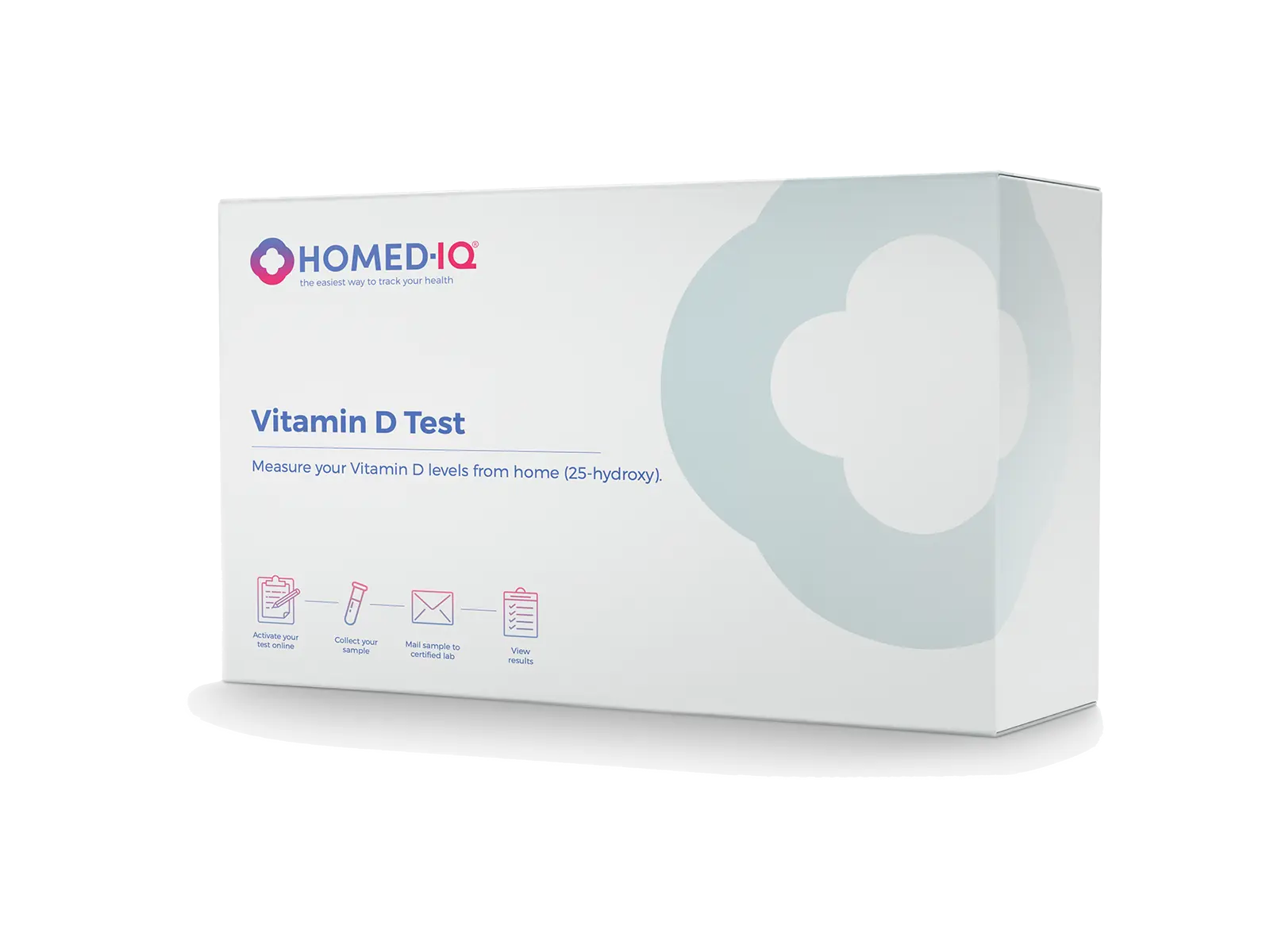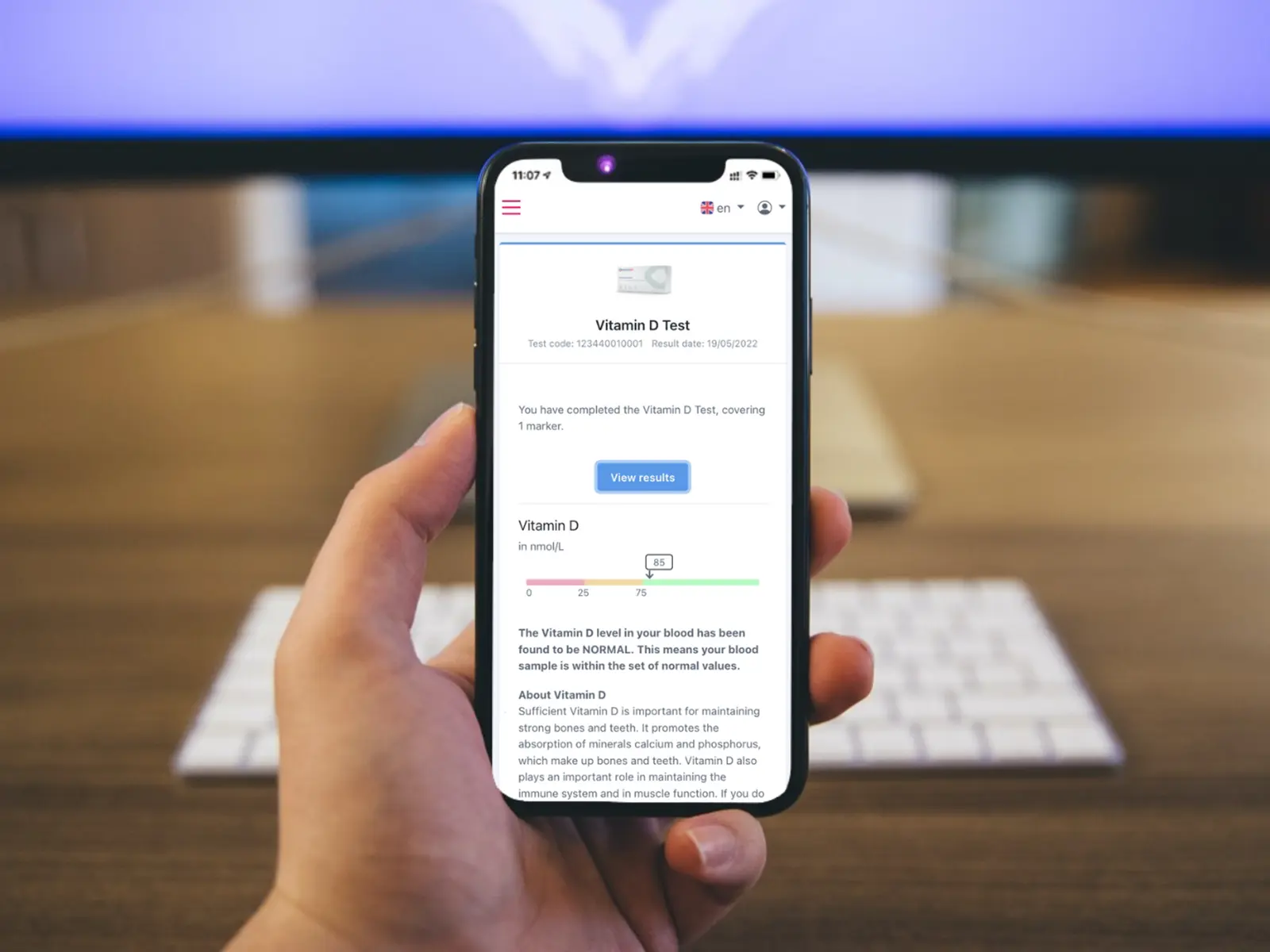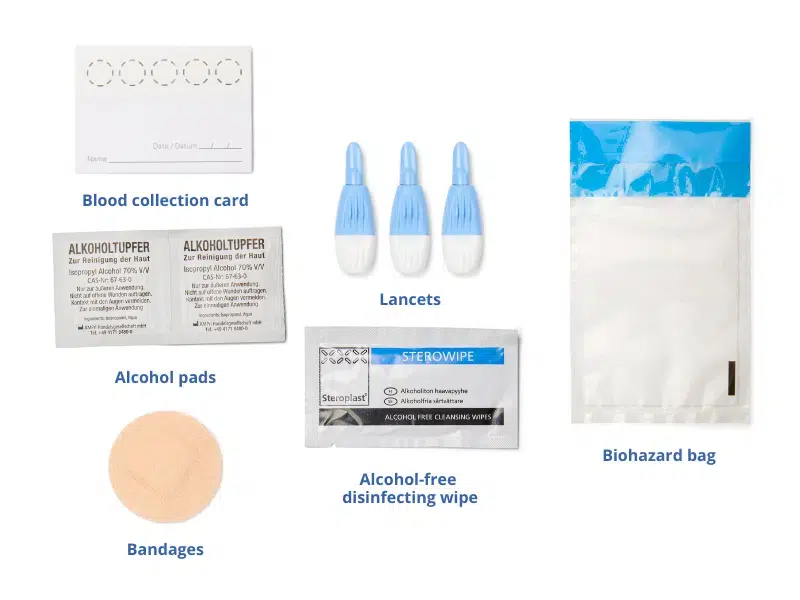

Vitamin D Test
€35,00
Free Shipping to
Sufficient vitamin D is important for both body and mind. Vitamin D is essential for bone health, maintaining the immune system, and can have a positive effect on your mood. However, many people living in Western Europe have insufficient levels of Vitamin D. Easily check your Vitamin D levels from home using this fingerprick test.
Test method: Finger prick Dry Blood Spot test
What do we test for?
About Vitamin D
Vitamin D is a fat-soluble hormone that plays a role in calcium and phosphate absorption in the body. Most vitamin D is produced by the human body itself. This happens when your skin is exposed to UV rays from the sun. Vitamin D can also be found in a number of foods of animal origin, such as egg yolks, fatty fish, and dairy products. Vitamin D can also be found in mushrooms and fortified foods. Vitamin D plays an important role in your body. It ensures the growth and maintenance of strong bones and teeth, ensures the functioning and recovery of your muscles, and promotes proper functioning of your immune system.
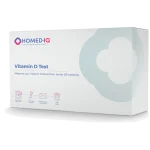
€35,00
Free Shipping to
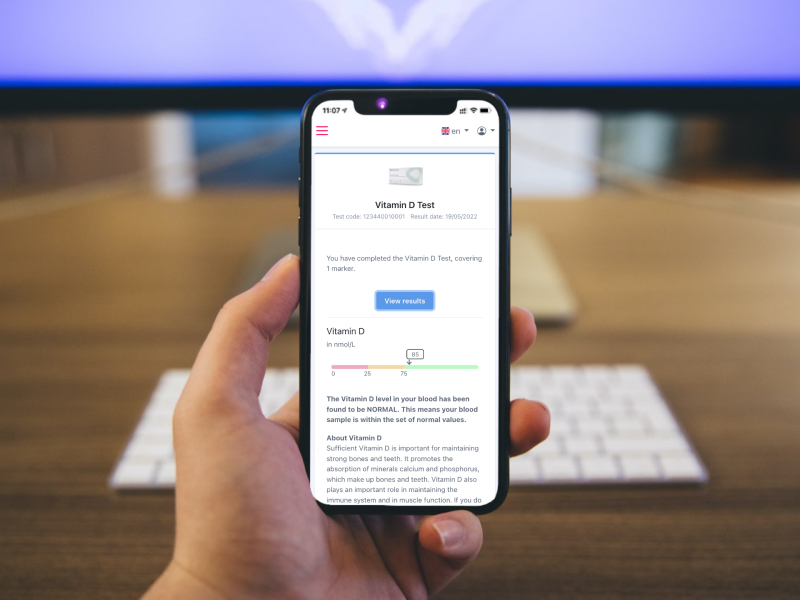
How does a Vitamin D test work?
This vitamin D test requires a finger prick blood sample. Before you begin, clean your finger thoroughly with provided alcohol wipes. After pricking your finger, deposit a few drops of blood onto the blood collection card until the collection circles are filled. Then, allow the blood collection card to dry completely. Next, close the collection card and repackage it in the test kit box. Lastly, send your blood sample to our certified laboratory in the prepaid return envelope. If your test arrives in the laboratory on a weekday, you will receive the test results within 24 hours.
What’s in the test kit?
The test kit contains:
- Instructions for use
- Lancets to collect a small blood sample
- A dry blood spot blood collection card
- Alcohol wipes
- Band-aids
- A protective transport bag
- A return envelope to send your sample to a certified partner laboratory
What type of test is this?
Homed-IQ’s Vitamin D Test is a IDK ® 25-OH-Vitamin D ELISA (from dried blood) manufactured by Immundiagnostik AG. This is a ELISA test that uses dried blood spot sampling. Information about this test can be found here. This test is CE marked for dried blood spot sampling, meaning it complies with applicable EU regulations for medical devices.
Vitamin D
Vitamin D is a fat-soluble hormone that plays a role in calcium and phosphate absorption in the body. Most vitamin D is produced by the human body itself. This happens when your skin is exposed to UV rays from the sun. Vitamin D can also be found in a number of foods of animal origin, such as egg yolks, fatty fish, and dairy products. Vitamin D can also be found in mushrooms and fortified foods.
Vitamin D plays an important role in your body. It ensures the growth and maintenance of strong bones and teeth, ensures the functioning and recovery of your muscles, and promotes proper functioning of your immune system.
Where does Vitamin D come from?
Vitamin D can be obtained from a variety of sources. The main source of vitamin D is sunlight. While vitamin D is not present in sunlight itself, it can be produced by the body when the skin is exposed to the sun’s rays. During exposure to sunlight, ultraviolet rays penetrate the skin which allow it to synthesize vitamin D. Vitamin D can also be obtained from food, such as fatty fish, mushrooms, and other fortified foods (orange juice, cereals, and certain dairy products). However, people who do not get much exposure to sunlight may not produce enough vitamin D, as it can be difficult to get sufficient vitamin D from diet alone. This is especially common in countries that do not often have sunny weather, or during the winter months. Checking your vitamin D level with a blood test can help you prevent a deficiency through increasing your exposure to sunlight, changing your diet, or using supplements.
When is a Vitamin D test useful?
Since vitamin D is one of the most common vitamin deficiencies, almost anyone can benefit from performing a test. This is especially true during the winter months, as people often get less vitamin D because it is dark for longer and spend more time indoors. It can also be useful to check your vitamin D level in other seasons, particularly if you do not spend much time outdoors during the day. If you are experiencing symptoms that could indicate a possible deficiency, it is also useful to do a vitamin D test. Gaining clarity about your vitamin D levels can help you get to the root of your symptoms and remedy a deficiency if needed.
Benefits of a Vitamin D test
There are several benefits to performing a vitamin D test from home. Most importantly, you don’t need to visit your doctor or a blood collection clinic. This means you can perform the test whenever you have time and as often as you want. You also often get your test results faster using a home test. Just like a blood sample collected in a clinic, all Homed-IQ tests are analyzed in a certified laboratory.
Benefits of home testing:
- Test when and where you want
- Fast test results
- Blood sample is examined by certified laboratory
- Test comes with downloadable laboratory report that can be brought to your doctor
What are the signs of a vitamin D deficiency?
Vitamin D deficiency can cause symptoms that affect your energy levels, mood, bones, and muscles. However, it is important to remember that these symptoms are not specific to a vitamin D deficiency, and can occur for a variety of reasons. Vitamin D deficiency can cause symptoms of:
- Fatigue
- Mood changes, such as depression
- Hypersensitive or bleeding gums
- Joint pain
- Muscle pain, tremors or cramps
- Weakened Bones (Osteoporosis)
- Increased susceptibility to infections
What are the signs of too much vitamin D?
High doses of vitamin D supplements and consumption of large amounts of vitamin D fortified foods can cause a buildup of vitamin D in the body, leading to a buildup of calcium in the blood and symptoms of toxicity. Symptoms of too much vitamin D can include:
- Nausea
- Vomiting
- Weakness
- Frequent urination
- Excessive thirst
How soon will I receive the results of this vitamin home test?
As soon as you have taken your sample and then sent it to our laboratory, it should take a few working days to receive your test result. As soon as your test kit arrives at the laboratory you will receive a notification by email. Once your test result is ready, you will receive a text message and an email with a link to your result. We will therefore keep you well informed throughout the entire testing process!
What is a healthy vitamin D level?
There are various reference values used to determine a healthy vitamin D level. Homed-IQ test results follow the following reference ranges:
- Deficiency: < 75 nmol/l, increased risk of bone diseases such as rickets, osteomalacia, and osteoporosis.
- Sufficient supply: 75-374 nmol/l, adequate supply in terms of bone health.
- Toxicity: > 374 nmol/l, Possible oversupply which can have negative health consequences for the body. For example, hypercalcemia can lead to cardiac arrhythmia or kidney stones.
Is it wise to take supplements based on this test result?
If your test result shows that you are deficient in vitamin D, we recommend that you first check whether you are receiving enough sunlight. It often helps a lot to go outside for half an hour every day between 11 am and 3 pm. Additionally, take a critical look at your diet. For example, do you eat enough oily fish? Regardless of lifestyle, it is recommended that elderly people, pregnant women, young children, individuals with a dark complexion, and those who do not go outside often take a daily Vitamin D supplement (NHS, 2021). You can get vitamin D supplements from the drugstore.
What do the results of this test mean?
Vitamin D deficiency:
A Vitamin D level that is too low indicates a vitamin D deficiency. Vitamin D deficiency can be caused by too little exposure to sunlight, a diet lacking in vitamin D rich foods, or insufficient absorption in the intestines. In order to treat a vitamin D deficiency, try and increase your intake by:
- Getting more sunlight.
- Adjusting your diet. For example, eating more oily fish, cheese, or mushrooms.
- Taking supplements. It is advised to consult a doctor before starting supplements in order to determine the right dose for you
Sufficient Vitamin D:
If your vitamin D levels are sufficient, it means you have enough vitamin D to maintain good bone and overall health. No changes are required at this point, but consider getting tested again in the future if your sunlight exposure, diet, or supplement use changes.
Vitamin D Toxicity
Too much vitamin D can cause vitamin D toxicity. Excessively high vitamin D can cause a buildup of calcium in the blood. Vitamin D toxicity is usually caused by consuming too many supplements. Treating high vitamin D requires stopping or decreasing supplement consumption. Speaking to a doctor about vitamin D supplements is important in ensuring you aren’t consuming too much.
Frequently asked questions
How do you know if you are deficient in vitamin D?
- Hypersensitive or bleeding gums
- Pain in joints
- Muscle pain
- Weakened bones
